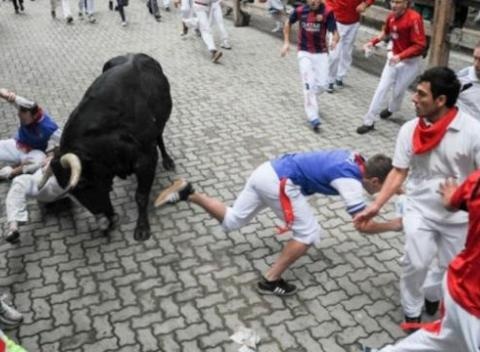3 runners pinned, gored in final running of bulls in Spain
PAMPLONA, Spain – A fighting bull
gored two Australians and a Spaniard, spreading panic in a hair-raising
final running of the bulls at Spain's San Fermin festival Monday.
Hundreds of people dashed alongside the six half-ton beasts and their accompanying steer through the cobblestone streets of Pamplona in the eighth run.
There were spine-chilling moments when one bull separated from the pack and charged three runners, pinning them against walls and barriers while trying to gore them.
A Navarra regional government statement said a 26-year-old Australian, identified only by his initials J.G., was gored in the chest, abdomen and left thigh.
It said a 24-year-old Australian with the initials, J.M. was gored in the right thigh. A 27-year-old Spaniard with the initials E.G.E. also suffered three horn wounds in the legs, the government said.
Five Spaniards were also hospitalized for other injuries.
The morning runs are the highlight of the nine-day street-partying festival immortalized in Ernest Hemingway's 1926 novel "The Sun Also Rises."
In the runs, hundreds of people test their speed and bravery by racing the bulls along a 930-yard course from a holding pen to the city's bull ring.
Dozens of people are injured each year in the "encierros," as the runs are called in Spanish, most of them in falls.
Besides the Australians, five Spaniards and one American were gored in this year's festival.
Fifteen people have died from gorings since record-keeping began in 1924.
Hundreds of people dashed alongside the six half-ton beasts and their accompanying steer through the cobblestone streets of Pamplona in the eighth run.
There were spine-chilling moments when one bull separated from the pack and charged three runners, pinning them against walls and barriers while trying to gore them.
A Navarra regional government statement said a 26-year-old Australian, identified only by his initials J.G., was gored in the chest, abdomen and left thigh.
It said a 24-year-old Australian with the initials, J.M. was gored in the right thigh. A 27-year-old Spaniard with the initials E.G.E. also suffered three horn wounds in the legs, the government said.
Five Spaniards were also hospitalized for other injuries.
The morning runs are the highlight of the nine-day street-partying festival immortalized in Ernest Hemingway's 1926 novel "The Sun Also Rises."
In the runs, hundreds of people test their speed and bravery by racing the bulls along a 930-yard course from a holding pen to the city's bull ring.
Dozens of people are injured each year in the "encierros," as the runs are called in Spanish, most of them in falls.
Besides the Australians, five Spaniards and one American were gored in this year's festival.
Fifteen people have died from gorings since record-keeping began in 1924.


No comments:
Post a Comment